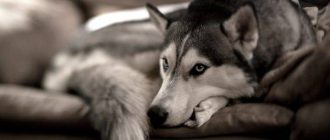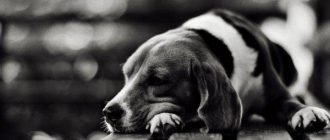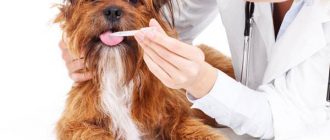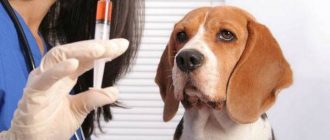Lichen is an unpleasant disease of an infectious nature that can affect both humans and domestic dogs. Infection affects the skin, pathogens can be pathogenic fungi or viruses. A sick dog is a danger to all members family and other pet, so it is extremely important to identify lichen in dog in the early stages and go to the veterinary the clinic.
Content
- 1. How infection occurs
- 2. Factors that increase the risk of infection
- 3. The main symptoms of lichen in dogs
- 4. Species depriving a dog of their symptoms
- 5. Treatment for lichen in dogs
How does infection happen?
Contents
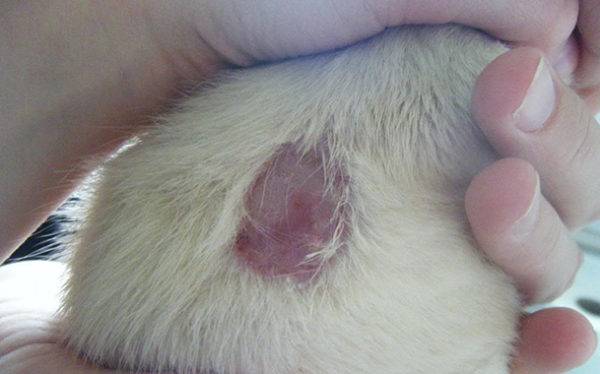
Photo depriving dogs
Fungal spores are one of the most resistant microorganisms to different conditions and can live in a variety of environments, therefore even outside the body remain viable for many months and even of the year. The most favorable for mushrooms is wet weather with high humidity, in this case they begin intensively multiply, affecting the upper layers of the skin of animals.
A dog infected with lichen becomes dangerous for its environment. He is able to infect not only his relatives, but also humans. Lichen is transmitted during contact with sick dogs.
Experienced dog breeders know that you should walk your pet with proven domestic dogs, and by all means should be avoided contact with stray dogs and cats.
Also depriving a pet can become infected while lying on someone else’s lying on a bed, eating from a plate of a sick animal or even playing his toys. Licensed ammunition can also become a source of ailment. dogs.
Factors that increase the risk of infection
There are a number of conditions that favor development. infections in the animal’s body. All of them, first of all, influence body immune forces:
- gestation and subsequent feeding of offspring;
- inadequate diet;
- recent illness caused by viruses;
- age – often deprive young animals and dogs older than 8 years old;
- diseases caused by oncology.
The main signs of lichen in dogs
First of all, the disease gives out the appearance of skin rashes that can appear anywhere or area of the body. FROM the development of infection, the area of damage increases significantly, skin covers with crusts of a reddish tint, begins hair fall out intensively. Absolutely bald on the body bald spots with clear boundaries. With advanced stages purulent exudate follows from a disease from under the crusts.
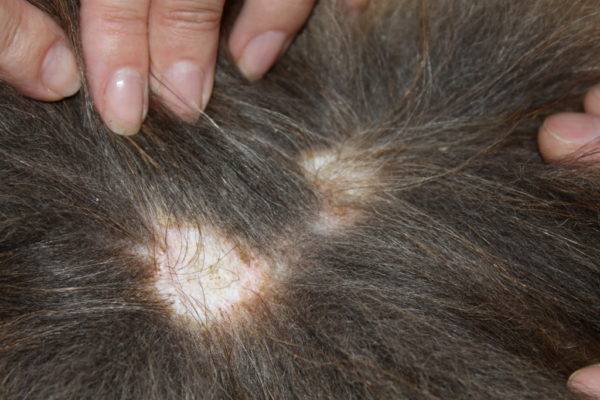
This is what ringworm looks like in a dog – Photo
Lichen, as a rule, is accompanied by severe itching, causing Pet comb the affected areas to the blood. If not show the pet in a timely manner to the veterinarian, then one should expect The following alarming symptoms of lichen in dogs:
- the appearance on the skin of inflamed colored spots, which are quite flaky;
- severe hair loss, which can lead to complete baldness, this symptom appears due to serious damage hair follicles;
- Pets infected with lichen become inactive, lethargic, get sick more often.
Species depriving a dog of their symptoms
There are several main types of lichen developing in pets:
- Pink lichen. It is considered one of the most dangerous types of lichen that threaten the health of the dog. Disease development begins with the occurrence of the 1st spot, which is called the maternal plaque. After it, a branch of other spots occurs, which are foci of infection. Plaques have a rounded shape, the size of about 2 cm in diameter, the color of the affected tissue is yellowish pink. This form of lichen is characterized by severe itching, so the dog constantly itches. Perhaps self-resolution of flaky foci 4-6 weeks after the appearance of the first lesion.
- Ringworm or Shingles in dogs. This type of lichen can affect any part of the pet’s body – torso, paws, paw pads, nose, claws. Recognize the disease can be on round or oval spots, intensively affecting skin integument of the pet. The foci of infection are covered by scales that bald and bother the animal intolerable itching. Looking closely at affected areas, you can see the hairs, which as as if cut off with scissors. Due to this symptom, pathology and got its name.
- Soaking lichen. Not a contagious disease skin integument. It develops against the background of allergic manifestations and is inflammatory in nature. The main signs of the disease swelling of the tissues, rash throughout the body. Affected Areas deliver the animal significant discomfort in the form of burning and itching. On the body of the dog spots appear, a shade of affected tissue varies from pale pink to blue. Also weeping type of lichen manifested in the form of cracking of the skin, vesicles, damaged patches are subsequently crusted.
- Pityriasis versicolor. Enough A common reason for dog owners to go to the vet. Initially, the ailment manifests itself in the form of a small spot of pink colors. At this stage, the disease proceeds without other symptoms. Later foci appear in various parts of the body. They acquire painful color – yellowish or brown.
- Shingles. The causative agent of this type A lichen infection is the herpes virus. The initial stage of the disease accompanied by itching in the abdomen and ribs. Later on the skin papules with liquid contents appear. Subsequently they burst and crust over. In the later stages, the disease affects and other parts of the animal’s body.
As soon as the primary signs of depriving are detected, determinations of the pet pathogen should be kept separate. For disinfection needs to be treated with chlorine-containing dog habitat means.
Read about other skin diseases in a dog about the causes red spots on the stomach.
Dog deprivation treatment
Only using complex therapy can save a four-legged friend from lichen. To facilitate the use of outdoor means it is necessary to cut off the hair near the affected areas.
Standard care for damaged lichen skin includes the following manipulations:
- it is necessary to wash the skin with warm water;
- wipe the damaged tissue with iodine;
- to treat with antimycotic drugs – Zoomikolem, Mykozolonum, etc.
Care should be taken that the pet does not lick medicinal funds from the skin. You can use veterinary collar.

Veterinary collar for dogs
To cure ringworm in a dog, you must apply stronger drugs with antifungal effects: Itraconazole, Yuglon, Dermatol, etc.
Simultaneous administration is prescribed to support liver function. hepatoprotective agents.
Highly effective in treating dogs with lichen introduction of vaccines – Wakderm, Mentavak, etc. Drugs are intended for intramuscular administration, the course is calculated by a veterinarian individually. The duration of this therapy varies from 2 to 2.5 months, and the result depends on the degree of development of the disease.
With an exacerbation of the disease in the dog, intense hair loss by shreds. On the body may appear multiple bald spots, but their complete absence is also possible. IN In this situation, it is recommended to wash the pet with shampoos with antifungal effect – Nizoral, Dermazole, Kenazole, Imaverol and others. These funds have a mild sparing effect, but they must be used in accordance with the attached instructions.
To avoid allergies to medications, veterinarians prescribe concurrent use antihistamines (Tavegil, Suprastin, Diazolin, Diphenhydramine and other)
After vaccination, the pet may worsen. However it is is a completely standard state – the body is natural by fighting pathogens that have infiltrated the vaccine.
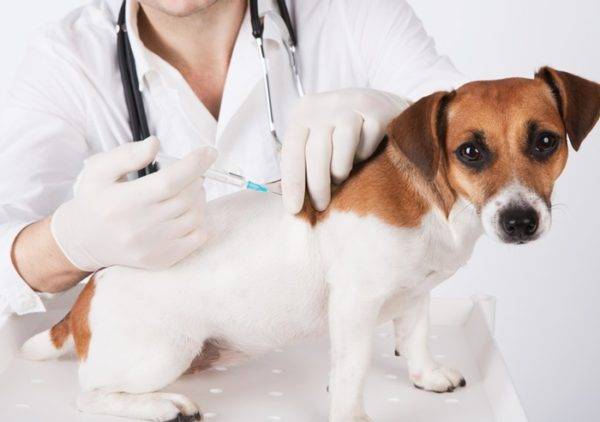
In addition to activating defense mechanisms, particular importance allocated to supporting animal immunity and improving overall condition. For this, doctors can prescribe the following groups:
- probiotics (normalize the activity of the digestive tract);
- immunomodulators (Katozal, Glycopin, Ribotan, Immunofan and other);
- vitamin complexes (Aminovit, Gamavit, Placentol, etc.).
To eliminate the causative agent of the disease – the fungus itself, Fungin and Yam spray in the form of ointment are applied. Put them not only on affected tissue, but also around the focus, capturing healthy areas. To facilitate application, it is recommended to cut the coat lesion areas.
For local treatment before applying external products use salicylic acid or iodine. But you can only do this after expert advice since improper use may cause necrosis of the surface of the dermis.
In modern veterinary medicine, there are no standard treatment regimens, since the causative agents of the disease constantly mutate. New strains parasitic microorganisms become more resistant to previously used substances, they adapt to the new environment, arising on the background of drugs.
However, the disease is still treatable; this requires timely appeal to a specialist and full comprehensive examination. An experienced veterinarian will draw up a treatment plan individually, based on the results and degree of development ailment. For dog owners, it’s important not to miss the first wake-up calls. Hope we told you how to treat lichen in a dog.

